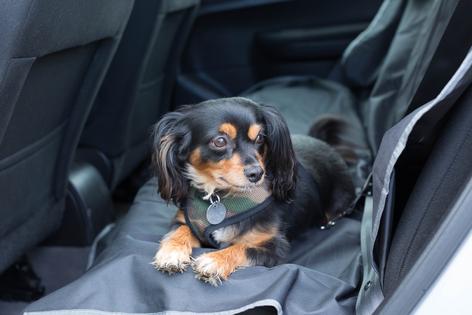My Pet World: Easing your dog’s car ride fears
Dear Cathy,
I have a three-year-old Shih Tzu mix who has brought tremendous joy to our household. The one major issue is her anxiety when traveling in a car. She pants incessantly throughout the ride but is fine as soon as it’s over. It doesn’t matter if it’s a 5-minute trip or a longer drive.
We’ve tried over-the-counter and veterinarian-prescribed medications with no success, as well as the Thundershirt® anxiety jacket, which didn’t help. Do you know any other methods we could try to overcome her fear?
— Larry, East Norwich, New York
Dear Larry,
Car anxiety is a common issue for dogs, and it can be frustrating when traditional remedies don’t work. While it may take some patience and experimentation, there are strategies you can try to make the ride less stressful for her.
First, make sure she is not experiencing car sickness. Car sickness can make any dog anxious. There are over-the-counter car sickness products you can try.
Second, try desensitization and counterconditioning. This involves gradually helping her associate the car with positive experiences. Start by sitting in the car with her without turning on the engine. Bring along some of her favorite treats, toys, or even a stuffed KONG® with peanut butter to distract her and reward her for calm behavior. Spend 5 minutes in the car the first time and work up to 15 minutes. Once she’s comfortable with this step, move on to turning on the engine without driving, continuing to offer rewards. Slowly progress to short trips — perhaps just around the block — as her comfort grows. Over time, this gradual exposure can help shift her perception of the car from a source of stress to one of positive reinforcement.
Next, create a comfortable and secure environment in the car. Some dogs feel safer in a crate, which can act as a den-like space. Adding a blanket or bed to the crate and covering it with a light sheet can reduce visual stimuli and might make her feel more secure. If she’s not crate-trained or doesn’t enjoy being confined, consider using a dog booster seat to see if that makes her feel safe.
Calming supplements and pheromones can help some dogs feel more relaxed without sedating them. While these are not guaranteed to work for every dog, they could be a helpful complement to these other strategies. Additionally, consider using calming music or white noise specifically designed for dogs. There are even playlists on streaming platforms tailored to help pets relax during stressful situations.
Before car rides, a good exercise session can also help reduce anxiety. A brisk walk or some playtime can burn off excess energy and may leave her more relaxed and less likely to focus on the stress of being in the car. During the ride, offering her a long-lasting chew or puzzle toy can serve as a healthy distraction and keep her mind occupied.
Please know that you’re not alone in dealing with this issue, and many pet owners face similar challenges. The key is persistence and finding what works best for your dog’s unique personality. I hope these suggestions help provide happier and more relaxed car rides in the future.
Dear Cathy,
We read your column in the Las Vegas Review-Journal and wanted to share our experience with your December 22 column about cats peeing outside the litter box. Our nine-year-old Russian Blue cat, Scout, exhibited similar behavior years ago. A year after the issue began, Scout suffered a disk rupture that temporarily left his hind legs paralyzed (he’s mostly recovered now, except for a limp). During that time, managing his accidents was challenging, and we resorted to using paper and dog training pads to catch the pee.
Eventually, we created a special litter box for him using a large storage bin. We cut an opening in the side to make it easy for him to access. It worked wonderfully, and Scout has been using it ever since. Now at 17 years old, he’s doing great!
— Mike, Las Vegas, Nevada
Dear Mike,
It’s wonderful to hear Scout is doing so well at 17 and that your creative solution worked. Using a large storage bin as a litter box is a fantastic idea and one that I often recommend to others. Some cats prefer larger boxes with more space, and accommodating their preferences can make all the difference. For older or mobility-challenged cats, cutting a low entry point can make it even easier to access.
Thank you for sharing your success story — it’s always inspiring to hear how devoted pet owners find solutions to help their beloved pets.
_____
_____
========
(Cathy M. Rosenthal is a longtime animal advocate, author, columnist and pet expert who has more than 25 years in the animal welfare field. Send your pet questions, stories and tips to cathy@petpundit.com. Please include your name, city, and state. You can follow her @cathymrosenthal.)
©2025 Tribune Content Agency, LLC.
(c) 2025 DISTRIBUTED BY TRIBUNE MEDIA SERVICES, INC.












Comments